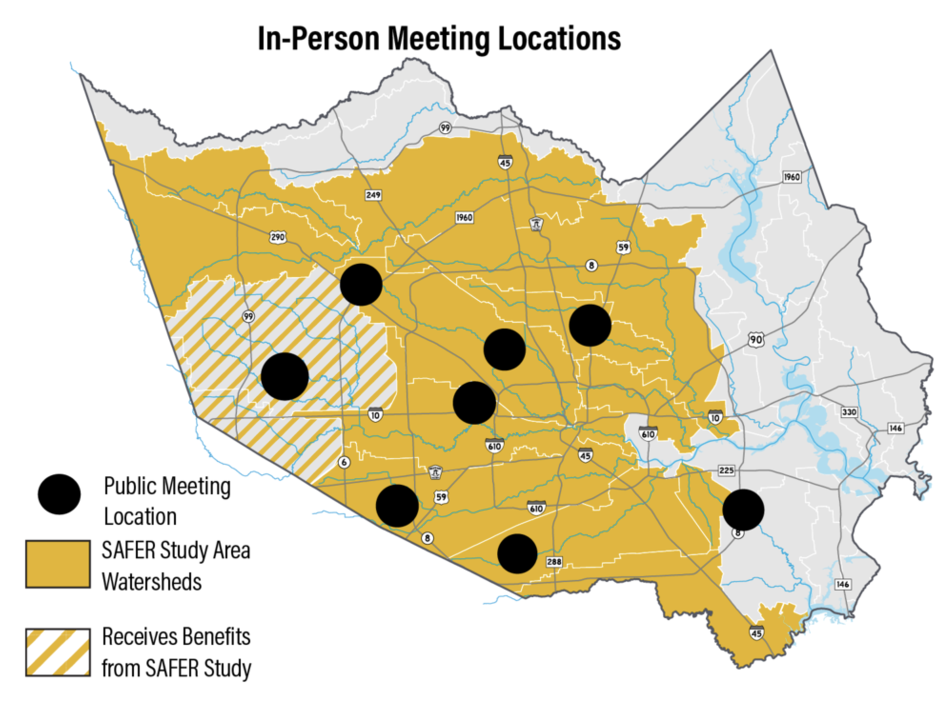
Public Input Sought as Harris County Launches SAFER Study to Tackle Long-Term Flood Risks
With the start of hurricane season and memories of past floods never far from mind, the Harris County Flood Control District is inviting residents to be part of a sweeping, community-driven effort to address flood risk across the region. This summer, the public is encouraged to attend a series of meetings for the SAFER Study—Solutions for Advancing Floodplain Evaluation and Resilience—a major feasibility study conducted in partnership with the U.S. Army Corps of Engineers.
The SAFER Study aims to identify large-scale, long-term solutions to reduce flood risks in Harris County, one of the most flood-prone counties in the nation. Residents will have multiple opportunities to engage during open house–style meetings held across the county in July and August 2025, as well as through virtual meetings and public comment submissions.
A Community-Guided Vision for Flood Resilience
At the heart of the SAFER Study is a bold, multi-year mission: to explore transformative flood mitigation strategies tailored to the needs of diverse communities. The study will examine flood risk reduction options across 11 watersheds—Brays, Buffalo, Clear Creek, Cypress, Greens, Halls, Hunting, Little Cypress, Sims, Vince, and White Oak Bayous—and evaluate both engineering feasibility and environmental impacts.
"The SAFER Study is not just about infrastructure—it’s about people, neighborhoods, and the future of Harris County," said Emily Woodell, Chief External Affairs Officer for the Harris County Flood Control District. "We want to hear directly from the residents who experience flooding firsthand. Their voices will help shape the solutions we ultimately pursue."
Each in-person meeting will function as an open house, allowing residents to speak directly with study representatives, review materials, and provide input. Meeting materials and interpretation services will be available in English, Spanish, Vietnamese, and Mandarin to ensure inclusivity across Harris County’s diverse population.
Mobile Sidebar Ad
In-Person and Virtual SAFER Study Meetings
Residents across Houston, Cypress, Pasadena, and beyond can attend any of the following in-person meetings:
Saturday, July 12 | 10:00 AM – 12:00 PM
Steve Radack Community Center, 18650 Clay Rd, Houston, TX 77084 (MAP)
Wednesday, July 16 | 5:00 – 7:00 PM
White Oak Conference Center, 7603 Antoine Dr Building A, Houston, TX 77088 (MAP)
Saturday, July 19 | 1:00 – 3:00 PM
Alief Community Center, 11903 Bellaire Blvd, Houston, TX 77072 (MAP)
Monday, July 21 | 5:00 – 7:00 PM
Trini Mendenhall Community Center, 1414 Wirt Rd, Houston, TX 77055 (MAP)
Tuesday, July 22 | 5:00 – 7:00 PM
Pasadena Convention Center, 7902 Fairmont Pkwy, Pasadena, TX 77507 (MAP)
Tuesday, July 29 | 5:00 – 7:00 PM
Hiram Clarke Multi-Service Center, 3810 W Fuqua St, Houston, TX 77045 (MAP)
Tuesday, August 12 | 5:00 – 7:00 PM
Telge Exhibit Center, 11206 Telge Rd, Cypress, TX 77429 (MAP)
Thursday, August 14 | 5:00 – 7:00 PM
North East Community Center, 10918 Bentley St, Houston, TX 77093 (MAP)
 (Source: HCFCD)
(Source: HCFCD)For those unable to attend in person, two live Zoom meetings will be offered:
-
Tuesday, August 19 | 6 – 7 p.m.
-
Wednesday, August 20 | 12 – 1 p.m.
Registration and access details for virtual sessions can be found at theSAFERstudy.org.
A Legacy of Flood Protection and a Look Ahead
Established in 1937 in the wake of devastating floods, the Harris County Flood Control District’s mission has remained focused: reduce flood risk through projects that consider both engineering data and community input. With collaboration from federal partners, the District works to secure funding and deliver solutions that respect natural systems and protect lives and property.
The SAFER Study, conducted under Section 203 of the Water Resources Development Act of 1986 (as amended), represents a significant step in this legacy. In addition to the feasibility report, the U.S. Army Corps of Engineers will prepare an Environmental Impact Statement (EIS) to examine the broader environmental implications of proposed strategies.
Residents who cannot attend meetings can still make their voices heard by submitting written comments to the Corps or through the SAFER Study website. Full details are available online.
Mobile Sidebar Ad
Why Public Input Matters
By participating, residents will help the Flood Control District and USACE refine the goals of the SAFER Study, prioritize critical issues, and shape a more resilient future. The feedback gathered during this public scoping phase will directly influence which flood mitigation options move forward for further evaluation and potential construction.
For questions, residents can contact the Flood Control District Communications Office at 346-286-4040 or email comments@theSAFERstudy.org.
Stay tuned with My Neighborhood News for continued updates on flood mitigation initiatives and infrastructure projects that impact your neighborhood. Harris County residents are encouraged to engage early and often—your input is helping build a SAFER tomorrow.
 Tiffany Krenek has been on the My Neighborhood News team since August 2021. She is passionate about curating and sharing content that enriches the lives of our readers in a personal, meaningful way. A loving mother and wife, Tiffany and her family live in the West Houston/Cypress region.
Tiffany Krenek has been on the My Neighborhood News team since August 2021. She is passionate about curating and sharing content that enriches the lives of our readers in a personal, meaningful way. A loving mother and wife, Tiffany and her family live in the West Houston/Cypress region.






